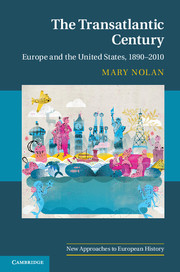Book contents
- Frontmatter
- Contents
- Illustrations
- Maps
- Tables
- Acknowledgments
- Introduction
- 1 An uncertain balance, 1890–1914
- 2 World War I: European crisis and American opportunity
- 3 Ambivalent engagement
- 4 The depression and transatlantic new deals
- 5 Strange affinities, new enemies
- 6 From world war to Cold War
- 7 Cooperation, competition, containment
- 8 Culture wars
- 9 The American Century erodes, 1968–1979
- 10 Renewed conflict and surprising collapse
- 11 A widening Atlantic
- 12 Imperial America, estranged Europe
- Suggested readings
- Index
- References
6 - From world war to Cold War
Published online by Cambridge University Press: 05 November 2012
- Frontmatter
- Contents
- Illustrations
- Maps
- Tables
- Acknowledgments
- Introduction
- 1 An uncertain balance, 1890–1914
- 2 World War I: European crisis and American opportunity
- 3 Ambivalent engagement
- 4 The depression and transatlantic new deals
- 5 Strange affinities, new enemies
- 6 From world war to Cold War
- 7 Cooperation, competition, containment
- 8 Culture wars
- 9 The American Century erodes, 1968–1979
- 10 Renewed conflict and surprising collapse
- 11 A widening Atlantic
- 12 Imperial America, estranged Europe
- Suggested readings
- Index
- References
Summary
World War II was both total and global in ways that its predecessor, despite its name, had not been: total in the economic and social mobilization required of the nations involved as well as in the unprecedented death and destruction of soldiers, cities, and civilians across Europe; global in the goals of belligerents and in the scope of the fighting, Europe being only one of several theaters of war. World War II was a war of competing empires and contradictory visions for transforming the global order. It was an ideological contest as well, pitting fascist regimes against an uneasy anti-fascist coalition of liberals, social democrats, and communists. World War II was a war of annihilation in which Nazi Germany and its collaborators committed genocide against Europe’s Jews, eliminated millions of others deemed racially inferior, and ruled other Europeans with methods of occupation and exploitation honed and previously deployed only in their colonies.
World War II dramatically transformed the European political, social, and economic landscape and restructured European-American relations more profoundly and permanently than World War I. America’s economic strength provided the necessary but not sufficient condition for it to become a superpower; war provided the occasion and created the intention to do so. It also opened the way for challenges to American hegemony from the much weaker Soviet Union. It marked the end of the European global era but not of European nations’ efforts to retain their distinctive identities, pursue autonomous domestic policies, and play a role in global affairs. To understand these dramatic postwar changes, we need to explore the origins and nature of the war, for the key events, contributions, and military and civilian costs to different combatants varied greatly as did the meanings assigned to the war at the time and later.
- Type
- Chapter
- Information
- The Transatlantic CenturyEurope and America, 1890–2010, pp. 154 - 190Publisher: Cambridge University PressPrint publication year: 2012

